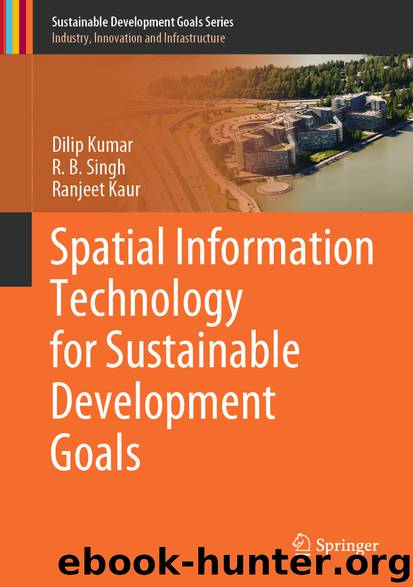Spatial Information Technology for Sustainable Development Goals by Dilip Kumar & R. B. Singh & Ranjeet Kaur

Author:Dilip Kumar & R. B. Singh & Ranjeet Kaur
Language: eng
Format: epub
ISBN: 9783319580395
Publisher: Springer International Publishing
The non-exact matching can be classified as hierarchical and fuzzy matching . Sometimes we create the lower units of a data set, for example a village boundary map, with their attributes. If we need higher hierarchy, such as with block-level, tehsil-level or district-level maps, we can add the village-level data set into a higher level or group the lower village-level data set into a higher block level, which is basically known as hierarchical matching (Fig. 6.11).
Fig. 6.11 Hierarchical matching
Generally, boundaries of different thematic maps do not match with each other. Some maps have administrative boundaries that can be matched but boundaries of the physical features cannot be matched, such as groundwater quality, rainfall , soil type and crops boundaries. If we want to know the groundwater quality and soil type of the same area then we have to merge all these data sets into a single map for multi-layer spatial analysis. Such matching is known as fuzzy matching (Fig. 6.12).
Fig. 6.12Fuzzy matching
Download
This site does not store any files on its server. We only index and link to content provided by other sites. Please contact the content providers to delete copyright contents if any and email us, we'll remove relevant links or contents immediately.
International Integration of the Brazilian Economy by Elias C. Grivoyannis(57499)
The Radium Girls by Kate Moore(10955)
Turbulence by E. J. Noyes(7098)
Nudge - Improving Decisions about Health, Wealth, and Happiness by Thaler Sunstein(6675)
The Black Swan by Nassim Nicholas Taleb(6245)
Pioneering Portfolio Management by David F. Swensen(5639)
Rich Dad Poor Dad by Robert T. Kiyosaki(5197)
Zero to One by Peter Thiel(4874)
Man-made Catastrophes and Risk Information Concealment by Dmitry Chernov & Didier Sornette(4793)
Secrecy World by Jake Bernstein(3816)
Millionaire: The Philanderer, Gambler, and Duelist Who Invented Modern Finance by Janet Gleeson(3604)
Skin in the Game by Nassim Nicholas Taleb(3508)
The Age of Surveillance Capitalism by Shoshana Zuboff(3456)
The Money Culture by Michael Lewis(3317)
Skin in the Game: Hidden Asymmetries in Daily Life by Nassim Nicholas Taleb(3295)
Bullshit Jobs by David Graeber(3219)
The Dhandho Investor by Mohnish Pabrai(3194)
The Wisdom of Finance by Mihir Desai(3113)
Blockchain Basics by Daniel Drescher(2920)
